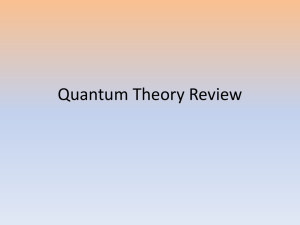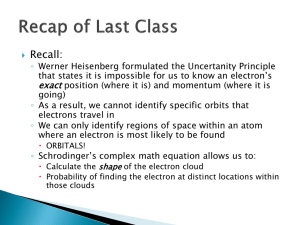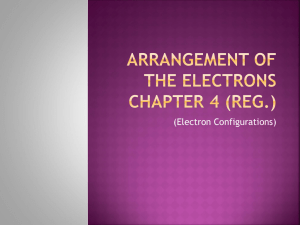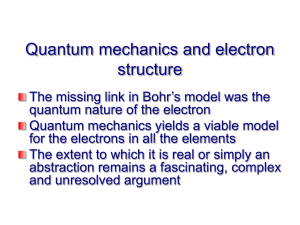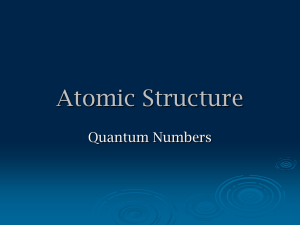Unit 1 Notes - Structure and Properties of Matter
advertisement
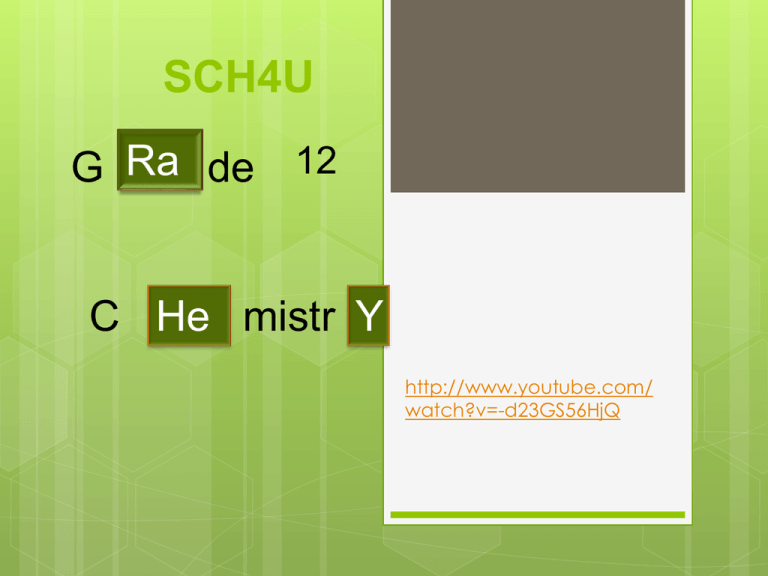
SCH4U G Ra de 12 C He mistr Y http://www.youtube.com/ watch?v=-d23GS56HjQ Dalton’s Theory Matter is made up of indestructible atoms. Law of definite proportions: Elements combine in a characteristic ratio Law of multiple proportions: Some elements have more than one combining capacity Law of conservation of mass: Atoms cannot be created nor destroyed Thomson’s Theory “The Raisin Bun” model: + and – charges are mixed together Gave us electrons Atoms can gain or lose electrons to form ions Said that the identity of an element was based on its number of electrons Rutherford’s Model Atoms have a tiny nucleus which contains positive & neutral charges and makes up the majority of the mass of the atom Electrons are negative and occupy most of the volume of the atom. Protons tell us the identity of the element Atoms and Isotopes Isotopes Have the same number of protons and electrons but have different amounts of neutrons. Radioisotopes – give off radioactivity when they decay Rutherford Model – Planetary Model of the Atom Electrons Protons Neutrons Particle Proton (p+) Mass (kg) 1.673 x 10-27 Location Charge Nucleus +1 -1 0 Electron (e-) 9.109 x 10-31 Orbitals outside nucleus Neutron (n0) 1.675 x 10-27 Nucleus Representing Atoms Z X A Problems - Revisited SPIRAL DEATH!!!! To solve this problem… we need a little bit more of an insight into two phenomena: LIGHT ENERGY Light is a Wave! Huygens, Newton Light is a Particle! (The Photoelectric Effect) • The ejection of electrons from a metal surface when light strikes it • Certain types of light cause ejection, others don’t Max Planck Spectrum of Radiated energy and intensity Quantum: unit or package of energy (plural quanta) Energy is quantize – can only have allowed values Planck Equation Energy is equal to the frequency of the radiation times Planck’s constant (h) h = 6.64×10-34 J∙s 𝐸 = ℎ𝑓 Energy is QUANTIZED – it comes in packets and the smallest packet is equal to Planck’s constant Only multiples of this number are allowed – nothing more Photons By extension, light is also a quantize, since it is a type of energy Photon: unit of light energy Or particles of light energy (Used to describe the photoelectric effect) Homework Page 142 #1-7 Bohr’s Model of the Atom Limitations of the Rutherford Model Electrons orbiting around a nucleus should lose energy and spiral into the nucleus Electrons should be attracted to proton and collapse in to the nucleus SPIRAL DEATH Atomic Spectra Continuous Spectrum: an emission spectrum that contains all the wavelengths of light in a specific region of the electromagnetic spectrum Line Spectrum: emission spectrum that contains only specific wavelengths characteristic of the element being studied Hydrogen Emission Spectrum Reason? Different for Each Element Bohr’s Postulates First Postulate: e- do not radiate energy as they orbit the nucleus. Each orbit corresponds to a state of constant energy (called stationary state). Basically energy states (or levels) Second Postulate: e- can change their energy only by undergoing a transition from one stationary state to another Basically, give the e- a quantum of energy and it’ll jump up to the next energy level, when it loses the quantum it falls back down, releasing a photon Bohr-Rutherford Model Successes and Failures of the Bohr Model Works well at predicting properties and periodicity of the elements Problem: everything was a little bit off after Hydrogen. Trends in the Periodic Table Atomic radius Ionization Energy Electron Affinity Electronegativity Homework THE QUANTUM MECHANICAL MODEL OF THE ATOM And now for something completely different… Quantum Mechanics The application of quantum theory to explain the properties of matter, particularly electrons in atoms Schrodinger’s Standing Waves Louis De Broglie developed a theory that matter can have wave-like properties Schrodinger extended this theory to electrons bound to a nucleus Postulated that electrons resembled a standing wave Certain orbitals exist at whole wavelengths of electron vibrations Orbitals - Redefined Orbital: region around the nucleus where there is a high probability of finding an electron As per wave model of Schrodinger – because things are vibrating Heisenberg Uncertainty Principle Heisenberg Uncertainty Principle Heisenberg studied statistics and developed matrix algebra Developed a statistical approach to explaining how electrons works and realized… IT IS IMPOSSIBLE TO KNOW THE EXACT POSITION AND SPEED OF ELECTRON AT A GIVEN TIME At best, we can describe the probability of finding it at a specific place Wave functions: the mathematical probability of finding an electron in a certain region of space Wave functions give us: Electron probability densities: the probability of finding an electron at a given location, derived from wave equations Homework Quantum Numbers Quantum Numbers: numbers that describe the quantum mechanical properties (energies) of orbitals From the solutions to Schrodinger’s equation The most stable energy states is called the ground state Principal Quantum Number (n) Integer number (n) used to level the main shell or energy level of the electron Describes size and energy of the atomic orbital Increase number = increase energy, bigger Secondary Quantum Number, l Describes the shape of the orbital within each shell Each energy level contains several sublevels Relates to the shape of the orbital Can be any integer from 0 to (n-1) Values of l Value 0 1 2 3 4 Letter Used s p d f g Name sharp principal diffuse fundamental Each orbital is given a code: Example If n = 1, l = 0 then we call it a 1s orbital If n = 3, l = 2 then we call it a 3d orbital Magnetic Quantum Number, ml Describes the orientation of the orbital in 3- space Can be whole number integers from – l to + l Example: if l = 1, then ml can be -1, 0, +1 There are 3 possible p orbitals px, py, and pz What are possible values for ml if l is: 0 1 2 3 Spin Quantum Number Electrons are basically little magnetics spin around when placed in magnetic fields, they can have spin ‘up’ or spin ‘down’ ms can be either +1/2 or – 1/2 Homework Electron Configurations and Energy Level Diagrams The four quantum numbers tell us about the energies of electrons in each atom Unless otherwise stated were are talking about ground state energies Energy Diagrams Describe how electrons fill orbitals using quantum numbers Electrons fill the lowest energy level orbitals first Each shell is (for the most part) filled before moving to higher shells Rules Use circles (or boxes) to represent each orbital in any given energy level and arrows for electrons Unoccupied circles imply that there are no electrons in it A circle can have at most two electrons in it; only if the arrows are pointing in opposite directions Rules Pauli exclusion Principle: no two electrons can have the same 4 quantum numbers. Electrons in the same orbital can’t have the same spin Hund’s Rule: One electron occupies each of several orbitals in the same energy level before a second can occupy the same orbital Aufbau Principle: each electron is added to the lowest energy orbital avaible Practice H, B, C, Ne Mg, P, Ar Ca, Mn, Zn, Ge, Kr Electron Configurations Condensed versions of orbital diagrams and not in Write the electron configuration for each of the atoms above Exceptions to the Rules


